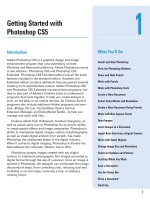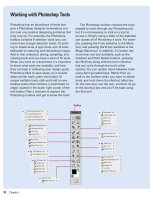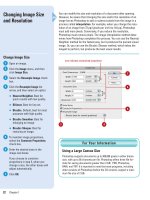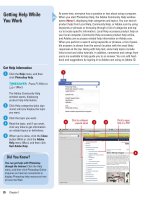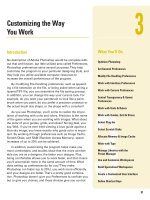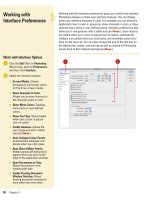Photoshop cs5 by steve Johnson part 55 doc
Bạn đang xem bản rút gọn của tài liệu. Xem và tải ngay bản đầy đủ của tài liệu tại đây (712.21 KB, 6 trang )
ptg
Chapter 14 Manipulating Images with Filters 341
Working with Liquify
View Options
Work with Liquify View Options
Open a document.
Select the Layers panel, and then
select the layer containing a
selection or mask.
Click the Filter menu, and then
click Liquify.
Select from the following Liquify
View options:
◆ Show Image. Shows/hides the
active image preview.
◆ Show Mesh. Displays a mesh
(grid) over the image preview.
◆ Mesh Size. Select between a
Small, Medium, or Large mesh.
◆ Mesh Color. Select a color for
the mesh.
◆ Show Mask. Shows/hides the
mask.
◆ Mask Color. Select a color for
the mask.
◆ Show Backdrop. Shows/hides
the backdrop.
◆ Use. Select what layers are
displayed in the image preview.
◆ Mode. Displays the active layer
either In Front, Behind, or
Blended with the other layers.
◆ Opacity. Determines the
blending opacity between the
individual layers.
Click OK.
5
4
3
2
1
The Liquify View Options control what you see in the preview window.
For example, you can choose to view or hide a mask, or even change
its color. If the image you're working on is in a transparent layer you
can even choose to view the image with or without the other image
layers. How you view the image is up to you; however, having choices
gives you greater control over the final results.
5
4
From the Library of Wow! eBook
ptg
342 Chapter 14
You may have noticed the Load Mesh and Save Mesh buttons, located
at the top of the Liquify dialog box. A mesh is a predefined Liquify oper-
ation. When you activate the mesh option, a mesh or grid is placed over
the image, and then as you use the Liquify tools, the mesh distorts and
bends. After applying a lot of work to a particular image, it's quite pos-
sible you might want to use that exact mesh on another image. That's
where the Load Mesh and Save Mesh options come into play. With the
click of a button you can create a mesh and use it over and over again.
Creating a Liquify
Mesh
Create a Liquify Mesh
Open a document.
Select the Layers panel, and then
select the layer on which you want
to use the Liquify tool.
Click the Filter menu, and then
click Liquify.
Select the Show Mesh check box.
Use the Liquify tools to adjust the
image.
Click Save Mesh.
Enter a descriptive name for the
mesh.
Click Save.
Click OK.
9
8
7
6
5
4
3
2
1
8
5
7
9
6
4
Did You Know?
You can display the distortion created
by the Liquify tools.
Check this option
to display a mesh (grid) over the image
preview. When you select the Show
Mesh check box, a mesh is applied to
an image, which distorts as you apply
the Liquify tools. When you clear the
Show Image check box (dimming the
image), you get a visual grid that repre-
sents the distortion values applied to
the image.
From the Library of Wow! eBook
ptg
Chapter 14 Manipulating Images with Filters 343
Applying a mesh to an image is a lot easier than redoing a particular
Liquify operation and to be honest, it would be virtually impossible to
reproduce a Liquify adjustment from scratch. That's why Adobe gives
you the option of creating, saving, and loading your very own personal-
ized meshes.
Applying a Liquify
Mesh
Apply a Liquify Mesh
Open a document.
Select the Layers panel, and then
select the layer on which you want
to use the Liquify tool.
Click the Filter menu, and then
click Liquify.
Select the Show Mesh check box.
Click Load Mesh.
Select a mesh.
Click Open.
The distortions generated by the
mesh are applied to the image.
Click OK.
8
7
6
5
4
3
2
1
6
7
8
5
4
Did You Know?
You can modify a loaded mesh.
Open a
mesh, and then use the Liquify options
to further distort the mesh pattern. That
way you can create a generic mesh
pattern and modify the pattern to fit
any design need.
From the Library of Wow! eBook
ptg
344 Chapter 14
The Lens Blur filter creates a varying depth of field so that certain
objects stay in focus and other areas become blurred. What stays in
focus and what is blurred is determined by a user-defined selection or
alpha channel. When the filter is activated, a depth map is created to
determine the three-dimensional position of the pixels in an image. If
you use an alpha channel, the black areas in the alpha channel are at
the front of the photo, and the white areas are in the distance.
Experiment with selections and alpha channel masks to see how pre-
cisely you can control the visual effect of blurring in an image.
Using the Lens Blur
Filter
Use the Lens Blur Filter
Open a document.
Select the Layers panel, and then
select the layer to which you want
to apply the Lens Blur.
Create a selection or alpha mask
to control the blur.
Click the Filter menu, point to Blur,
and then click Lens Blur.
The Lens Blur dialog box opens.
4
3
2
1
3
2
1
See Also
See “Using the Gaussian Blur and
Despeckle Filters” on page 160 for
information on using filters.
From the Library of Wow! eBook
ptg
Chapter 14 Manipulating Images with Filters 345
Select from the following options:
◆ Preview. Select Faster to
generate quicker preview, or
More Accurate to view the
image with the filter applied.
◆ Depth Map. Select a source
from the Source list arrow.
◆ Blur Focal Distance. Drag the
slider to set the depth at which
pixels are in focus. The higher
the value, the greater the
effect.
◆ Invert. Inverts the selection or
alpha channel.
◆ Shape. Select an iris option
from the Shape list arrow.
◆ Radius. Drag the slider to add
more blur.
◆ Blade Curvature. Drag the
slider to smooth out the edges
of the iris.
◆ Rotation. Drag the slider to
rotate the iris.
◆ Brightness. Drag the slider to
increase the brightness of the
highlights.
◆ Threshold. Drag the slider to
select a brightness cutoff so
that all the pixels that are
brighter than that value are
treated as highlights.
◆ Amount. Drag the slider to add
or remove noise.
◆ Uniform or Gaussian. Select
one method to add noise to an
image.
◆ Monochromatic. Adds noise
without affecting the color in
your image.
Click OK.
6
5
5
Image with Lens Blur filter applied
6
From the Library of Wow! eBook
ptg
346 Chapter 14
The Photo Filter command reproduces the same effect of placing a col-
ored filter in front of the camera lens when you take a picture.
Photographers place colored filters in front of a camera lens to adjust
the color balance of the image and control the color temperature of the
light transmitted through the lens. In addition to simulating a color filter,
the Photo Filter command also lets you select a color preset and apply
a specific hue adjustment to an image. If you want to apply a custom
color adjustment, the Photo Filter command lets you specify a user-
defined color using the Adobe Color Picker.
Working with Photo
Filters
Work with Photo Filters
Open a document.
Select the Layers panel, and then
select the layer to which you want
to apply the Photo Filter.
Click the Image menu, point to
Adjustments, and then click Photo
Filter.
Select the Preview check box to
view the results of the color filter
directly in the active document
window.
Select from the following options:
◆ Filter. Click the list arrow, and
then select from the available
filter presets.
◆ Color. Click the color box, and
then select a color using the
Color Picker dialog box.
◆ Density. Drag the slider to
increase or decrease the
impact the color has on the
image.
◆ Preserve Luminosity. Select the
check box to prevent the
image’s lightness values from
being changed as a result of
adding a color filter
(recommended).
Click OK.
6
5
4
3
2
1
5
6
4
1
From the Library of Wow! eBook
